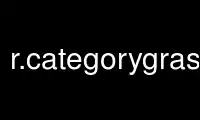
This is the command r.categorygrass that can be run in the OnWorks free hosting provider using one of our multiple free online workstations such as Ubuntu Online, Fedora Online, Windows online emulator or MAC OS online emulator
PROGRAM:
NAME
r.category - Manages category values and labels associated with user-specified raster map
layers.
KEYWORDS
raster, category
SYNOPSIS
r.category
r.category --help
r.category map=name [cats=range[,range,...]] [values=float[,float,...]]
[separator=character] [raster=name] [rules=name] [format=string]
[coefficients=mult1,offset1,mult2,offset2] [--help] [--verbose] [--quiet] [--ui]
Flags:
--help
Print usage summary
--verbose
Verbose module output
--quiet
Quiet module output
--ui
Force launching GUI dialog
Parameters:
map=name [required]
Name of raster map
cats=range[,range,...]
Category values
Example: 1,3,7-9,13
values=float[,float,...]
Comma separated value list
Example: 1.4,3.8,13
separator=character
Field separator
Special characters: pipe, comma, space, tab, newline
Default: tab
raster=name
Raster map from which to copy category table
rules=name
File containing category label rules (or "-" to read from stdin)
format=string
Default label or format string for dynamic labeling
Used when no explicit label exists for the category
coefficients=mult1,offset1,mult2,offset2
Dynamic label coefficients
Two pairs of category multiplier and offsets, for $1 and $2
DESCRIPTION
r.category prints the category values and labels for the raster map layer specified by
map=name to standard output. You can also use it to set category labels for a raster map.
The user can specify all needed parameters on the command line, and run the program
non-interactively. If the user does not specify any categories (e.g., using the optional
cats=range[,range,...] argument), then all the category values and labels for the named
raster map layer that occur in the map are printed. The entire map is read using
r.describe, to determine which categories occur in the map. If a listing of categories is
specified, then the labels for those categories only are printed. The cats may be
specified as single category values, or as ranges of values. The user may also
(optionally) specify that a field separator other than a space or tab be used to separate
the category value from its corresponding category label in the output, by using the
separator=character|space|tab option (see example below). If no field separator is
specified by the user, a tab is used to separate these fields in the output, by default.
The output is sent to standard output in the form of one category per line, with the
category value first on the line, then an ASCII TAB character (or whatever single
character or space is specified using the separator parameter), then the label for the
category.
NOTES
Any ASCII TAB characters which may be in the label are replaced by spaces.
The output from r.category can be redirected into a file, or piped into another program.
Input from a file
The rules option allows the user to assign category labels from values found in a file.
The label can refer to a single category, range of categories, floating point value, or a
range of floating point values. The format is given as follows (when separator is set to
colon).
cat:Label
val1:val2:Label
If the filename is given as "-", the category labels are read from stdin
Default and dynamic category labels
Default and dynamic category labels can be created for categories that are not explicitly
labeled. The coefficient line can be followed by explicit category labels which override
the format label generation.
0:no data
2: .
5: . ## explicit category labels
7: .
explicit labels can be also of the form:
5.5:5:9 label description
or
15:30 label description
In the format line
· $1 refers to the value num*5.0+1000 (ie, using the first 2 coefficients)
· $2 refers to the value num*5.0+1005 (ie, using the last 2 coefficients)
$1.2 will print $1 with 2 decimal places.
Also, the form $?xxx$yyy$ translates into yyy if the category is 1, xxx otherwise. The
$yyy$ is optional. Thus
$1 meter$?s
will become:
1 meter (for category 1)
2 meters (for category 2), etc.
format=’Elevation: $1.2 to $2.2 feet’ ## Format Statement
coefficients="5.0,1000,5.0,1005" ## Coefficients
The format and coefficients above would be used to generate the following statement in
creation of the format appropriate category string for category "num":
sprintf(buff,"Elevation: %.2f to %.2f feet", num*5.0+1000, num*5.0*1005)
Note: while both the format and coefficent lines must be present a blank line for the
format string will effectively suppress automatic label generation.
To use a "$" in the label without triggering the plural test, put "$$" in the format
string.
Use ’single quotes’ when using a "$" on the command line to avoid unwanted shell
substitution.
EXAMPLES
Spearfish sample dataset:
r.category map=soils
prints the values and labels associated with all of the categories in the soils raster
map layer;
r.category map=soils cats=10,12,15-20
prints only the category values and labels for soils map layer categories 10, 12, and
15 through 20; and
r.category map=soils cats=10,20 separator=’:’
prints the values and labels for soils map layer categories 10 and 20, but uses ":"
(instead of a tab) as the character separating the category values from the category
values in the output.
Example output:
10:Dumps, mine, Cc
20:Kyle clay, KaA
Example defining category labels:
r.category diseasemap separator=: rules=- << EOF
1:potential absence
2:potential presence
EOF
sets the categoy values 1 and 2 to respective text labels.
Use r.categorygrass online using onworks.net services
